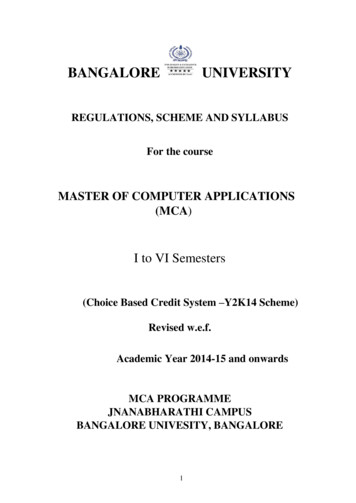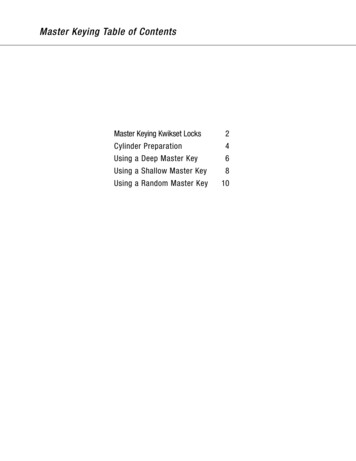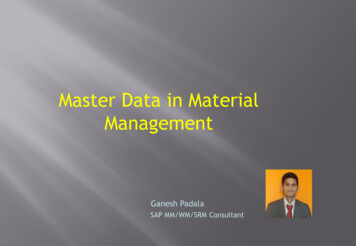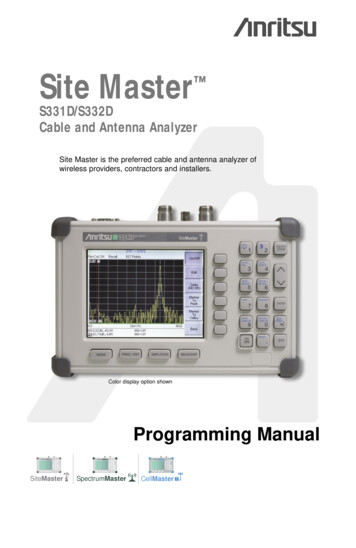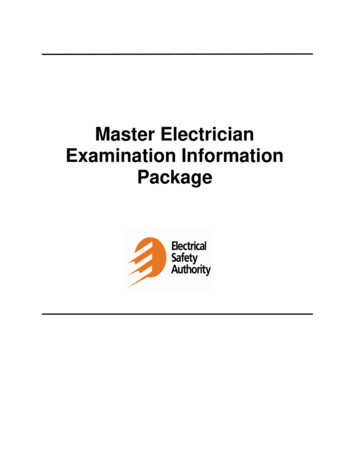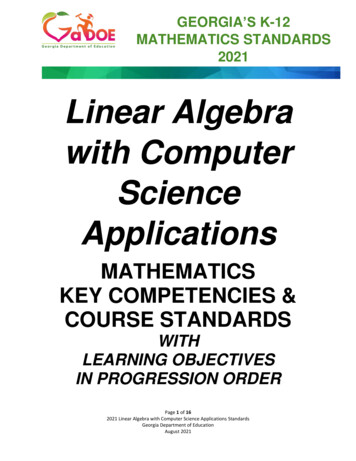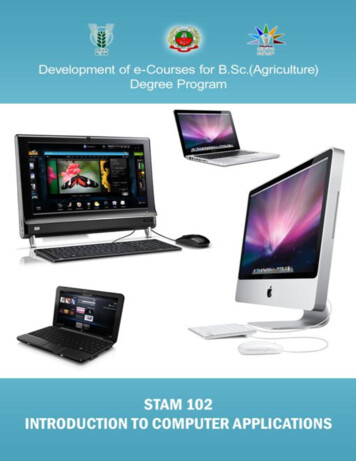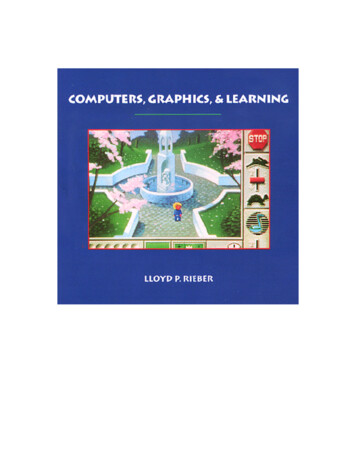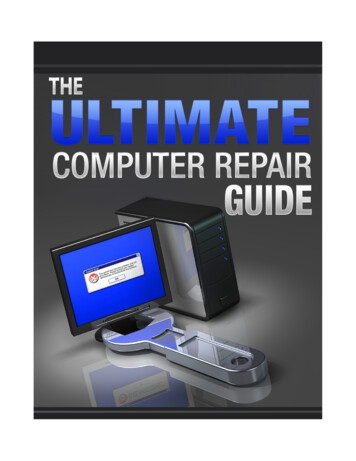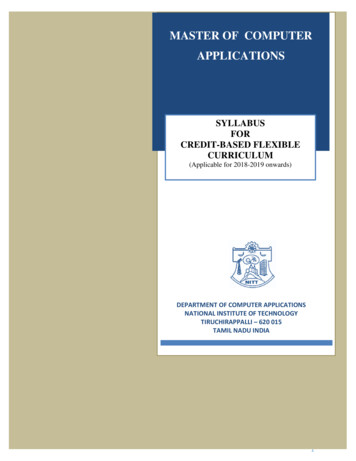
Transcription
MASTER OF COMPUTERAPPLICATIONSSYLLABUSFORCREDIT-BASED FLEXIBLECURRICULUM(Applicable for 2018-2019 onwards)DEPARTMENT OF COMPUTER APPLICATIONSNATIONAL INSTITUTE OF TECHNOLOGYTIRUCHIRAPPALLI – 620 015TAMIL NADU INDIA1
SYLLABUSMASTER OF COMPUTER APPLICATIONSCREDIT-BASED FLEXIBLE CURRICULUM(Applicable for 2018-2019 onwards)DEPARTMENT OF COMPUTER APPLICATIONSNATIONAL INSTITUTE OF TECHNOLOGYTIRUCHIRAPPALLI-620 015TAMIL NADU - INDIA2
About us:About us:The Department of Computer Applications is one of the pioneering departments of theinstitution that offers the following degree programmes:1. Three year Master of Computer Applications (MCA)2. Two year Master of Science in Computer Science and3. Two year Master of Technology in Data Analytics.The Department of Computer Applications is one among the top five offering MCA courses in thecountry. It is committed to impart quality education in the sub-fields of IT, a field growing in leapsand bounds.Vision:Towards a school of Information Science and Technology conforming to internationalstandardsMission:o To offer state-of-art education in Information Science and Technologyo To provide strong theoretical foundation complemented with extensive practical trainingo To inculcate value-based, socially committed professionalism to the cause of overalldevelopment of students and societyMASTER OF COMPUTER APPLICATIONSObjectives of the Programme:1. Prepare graduates to become computer professionals with comprehensive knowledge andskills to produce software for emerging requirement2. Prepare graduates to become continuous learner with aptitude for teaching and researchwith societal focus3. Prepare graduates to become Consultant / Entrepreneurs in the IT and ITES industries withconfidence in self-employment3
The board of studies for Computer Applications Department includes the followingmembers: Chairman:Dr. S.R.Balasundaram, ProfessorHead of the department External Experts:1. Dr.V.S.Ananthanarayana , Dean(R&C)Professor, Department of ITNIT K Surathkal2. Mr.S.Parthasarathy,Vice-presidentSystech Solutions Pvt. Ltd Faculty Members:1. Dr. N.P. Gopalan, Professor2. Dr. A.V. Reddy , Professor3. Dr. B. Ramadoss, Professor4. Dr.S.Nickolas, Professor5. Dr. Michael Arock, Professor6. Dr. P.J.A Alphonse, Professor7. Dr. S. Domnic , Associate Professor8. Dr. (Mrs) B.Janet , Assistant Professor9. Dr. (Mrs) S. Sangeetha, Assistant Professor10. Dr. (Mrs). R. Eswari, Assistant Professor11. Dr. U. Srinivasulu Reddy, Assistant Professor12. Dr. C.Sivaraj13. Dr. (Mrs). Adlin Suji14. Ms. Cynthia Devi15. Ms. Jenie Arock16. Mr.K.Vignesh4
SEMESTER BJECT NAMELTPCData Structures and Applications3Mathematical Foundations of Computer3ApplicationsComputer Organization and Architecture3Accounting and Financial Management3Probability and Statistical Methods2Data Structures Lab using C0Business Communication0Design and Analysis of Algorithms2Database Systems3Operating Systems3Object Oriented Programming2Resource Management Techniques3DBMS Lab0OS Lab0Data Mining Techniques2Python and R Programming3Software Engineering2Computer Networks3Object Oriented Analysis and Design2Networks Lab0Data Mining Lab0Organizational Behavior3Information Security3Distributed Technology3Web Technology and Its Applications3Elective I3Web Technology and Its Application Lab0Information Security Lab0Artificial Intelligence3Cloud ificial Intelligence Lab0Mini Project Work0Project WorkMandatoryInternship I – II Semester vacationInternship II – III Semester vacationGrand Total 22333332210---5401055
L: LECTURE T: TUTORIAL P: PRACTICAL C: CREDITSLIST OF CA7C4CA7C5CA7C6CA7C7CA7C8SUBJECT NAMEBusiness IntelligenceUnix and Shell ProgrammingVisual ProgrammingSoftware Architecture and Project ManagementBusiness EthicsGreen ComputingImage ProcessingInternet of ThingsMarketing ManagementSoft ComputingAdvanced Database TechnologyModeling and Computer SimulationComputer VisionHuman Computer InteractionBioinformaticsDeep learningMulti-core ProgrammingMEAN Stack Web DevelopmentBig Data ManagementEvolutionary ComputingSocial Network 0000000000000000000000000333333333333333333333L: LECTURE T: TUTORIAL P: PRACTICAL C: CREDITS6
SEMESTER-ICA711 DATA STRUCTURES AND APPLICATIONSCourse Objective: To introduce different data structures; searching and sorting techniques and theirapplications.Linear data Structures – Arrays, Records, Linked Lists – Singly, Doubly, Circular linked lists Stack: Definition and examples, Representing Stacks - Queues: Definition and examples, priorityqueue, Deque, IRD, ORD – Applications of Stack, Queue and Linked Lists- Hashing.Non-Linear data Structures - Binary Trees – Binary Tree Representations – node representation,internal and external nodes, implicit array representation - Operations on binary trees – Binary treeTraversals – Binary search trees- insertion, deletion, find. Graphs – Representation – Linkedrepresentation of Graphs – Graph Traversals.Advanced data structures –Data structures for disjoint sets- AVL trees - Red-black trees – insertionand deletion – B-trees – Definition, insertion, deletion – Splay tree, Binomial heaps – operations.Single source shortest path algorithms – Bellman-Ford algorithm and Dijkstra's algorithmTransitive closure -Topological sort – Trie Structures.Basic sorting techniques – selection sort, bubble sort, insertion sort - Merging and merge sort –Basic Search Techniques – linear search and binary search – recursive and non-recursivealgorithms.REFERENCES:1. T.H. Cormen, C.E. Leiserson, R.L. Rivest and C.Stein, “Introduction to Algorithms”, 3rdEdition, MIT Press, 2009.2. S. Lipschutz and G.A.V. Pai, “Data Structures”, Tata McGraw-Hill, 2010.3. M.A.Weiss, “Data Structures and Problem Solving using Java”, 4th Edition, Addison Wesley,2009.4. D. Samanta, “Classic Data Structures”, 2nd Edition, PHI, 2009.5. P. Brass, “Advanced Data Structures”, Cambridge University Press, 2008.Outcomes:Students will be able to1. Write structured pseudo code for the given problem2. Use linear and nonlinear data structures to solve real-time problems3. Apply basic searching and sorting techniques in different application domains7
CA713 MATHEMATICAL FOUNDATIONS OF COMPUTER APPLICATIONSObjective: To learn the mathematical foundations applicable to computing.Sets - Relations – Posets - Functions - Mathematical Inductions (Simple and strong) – Principlesof Counting (Addition & Multiplication).Graphs - Basic concepts - Isomorphism – complements - Matrix representation of graphs - Trees,Spanning trees, Minimal Spanning tree Algorithms - Euler graphs - Hamiltonian graphs.Recurrence Relations and Generating Functions - Homogeneous and non-homogeneousrecurrences and their solutions - solving recurrences using generating functions.Mathematical Logic – Predicate Calculus – Scope – Binding – Resolution – Regular Grammars.Finite Automata – Context-Free Grammars – Chomsky’s Normal form -Griebach Normal Form Push-down Automata - Equivalence of CFL’s and PDA’s - Non-context free languages.REFERENCES:1. Thomas Koshy, “Discrete Mathematics with Applications”, Elsevier,2006.2. NarsinghDeo, “Graph theory and applications to Engineering and Computer Science”,PHI, 1986.3. Arthur Gill, “Applied Algebra for the Computer Sciences”, Prentice Hall,1976.4. Michael Sipser, “Introduction to Theory of Computation”, PWS Publishing Co,1996.Outcomes:Students will be able to1. Explain functions and related concepts and illustrate its direct application in Computerlanguages2. Solve the problems using the concepts of Graphs, Trees3. Deduce complex task by various Mathematical logic4. Solve recurrence relations for a given problem8
CA715 COMPUTER ORGANIZATION AND ARCHITECTUREObjectives To understand the data representation in a digital computer and explain how operations areperformed by computer circuitsTo study and analyze the internal components of a computer and evaluate the performanceof CPU, memory and I/O operationsStudy and analyze the modern processor architectureNumber Systems - Binary Arithmetic - Boolean algebra - Map Simplifications - Gates Combinational Circuits - Sequential Circuits.Memory: Internal - External - Memory Organization - Associative - Cache – Virtual memory.CPU: Arithmetic And Logic Unit - Instruction Sets - RISC - CISC - Instruction pipeline Addressing modes and formats - Register organization - Control Unit Operation - Processororganization.External Devices: I/O modules - Programmed I/O - Interrupt Driven I/O - Direct Memory Access- I/O Channels - Asynchronous Data Transfer.Processors: Parallel – Multi-core – Mobile – Embedded – GPU and TPU.REFERENCES:1. William Stallings, "Computer Organization and Architecture", 10th Edition, PHI,20162. M. Morris Mano, Michael D. Ciletti, "Digital Design", 5th Edition, Pearson Education, 2013.3. Hennessy J. and Patterson D., "Computer Architecture: A Quantitative Approach", 6th Edition,Morgan Kaufmann, 2017.Outcomes:1. Define binary number system and arithmetic operations. Design Boolean circuit for a givenproblem2. Analyze the different types of memory and their organization3. Describe the functional units of the CPU and its organization4. Discover the working and organization of I/O Devices5. Evaluate the different modern processor architecture9
CA717 ACCOUNTING AND FINANCIAL MANAGEMENTObjective: To learn the fundamentals of accounting and financial managementoAssets – Liabilities – Types - Trading account – Accounting records and Systems – Limitations Income statement – Preparation and Interpretation.Depreciation – Methods - Inventory methods, Sources of working capital, Fund flows, Cash flows– Financial Statement analysis- Case studies.Ratio analysis - Use of ratios in interpreting Trading Accounts and Financial Statements,Limitations – Management Accounting.Variable costs – Fixed costs – Cost Volume Profit Analysis – Break even marginal and full costingcontribution, Standard costing - Analysis of variance - Computer accounting and algorithms.Characteristics of Budgets - Forecasting – Long term, Short term – Methods of capital investmentdecision making, Sensitivity Analysis, Cost of capital.REFERENCES:1. S.N. Maheswari and S.K. Maheswari, “An Introduction to Accountancy”, 11th Edition, VikasPublishing, 2013.2. Manmohan and Goyal, “Principles of Management and Accounting”, 5th Edition,SahityaBhawan, 1994.Outcomes:Students will be able to:1. Prepare and analyse the final accounts of the firm2. Prepare and analyse the funds & cash flow statements of the firm3. Perform basic analysis of financial statements and write a report on the financialperformance, conditions and effectiveness of the firm4. Analyse and evaluate costing systems5. Prepare different types of budgets and policies10
CA719 PROBABILITY AND STATISTICAL METHODSObjective: To learn the fundamentals of probability and statistical methodsProbability Spaces- Combinatorial methods (or) Counting techniques- Elementary Theorem –Conditional Probability – Bayes’ theorem- Probability Distributions and Probability Densities.Mathematical Expectation: Expected value- Moments- Chebyshev’s theorem- Moment Generatingfunctions-Product Moment-Conditional Expectation- Special Probability Distributions andProbability Densities- Functions of Random Variable. Multiple regression- Linear modelsLogistic regression- Rates and Poisson regression- Nonlinear curve fitting – correlation.Descriptive Statistics & Sampling Distributions: Population-Sampling- Measures of Centraltendency, variations and position – Sampling distributions: Standard Normal Distribution- ChiSquare Distribution- t-Distribution –F-Distribution -The Central Limit Theorem.Estimation: Point Estimation: the method of moments and the method of maximum likelihoodestimation- Interval estimation: estimation of mean, estimation of difference of means, estimationof variance and estimation of ratio of variances.Test of Hypothesis- Testing for Attributes – Mean of Normal Population – One-tailed and twotailed tests, F-test and Chi-Square test – Analysis of Variance- Nonparametric test.REFERENCES:1. John.E.Freund, Irwin Miller, Marylees MillerApplications “, 8th, Prentice Hall of India, 2014“MathematicalStatisticswith2. Yannis viniotis, “Probability and Random Processes for electrical engineers”, McGraw-HillInternational Edition, 1997.3. Ross, Sheldon. M, “Introduction to Probability and Statistics for Engineers and Scientists”,Academic Press, 2009.Outcomes:Students will be able to1. Explain basic probabilistic and statistical models and illustrate their related applications2. Estimate the likelihood of events from population3. Propose, test and evaluate hypothesis11
CA701 DATA STRUCTURES LAB USING CExercises for learning basic features of C and exercises to implement various data structures forreal world applicationsOutcomes:Students will be able to:1.2.3.4.Write C programs for solving any problems.Implement linear and nonlinear data structures to solve real-time problemsPerform searching and sorting techniques to different application domainsImplement different design strategies to solve complex problemsCA703 BUSINESS COMMUNICATIONObjective: Introduce the dynamics of Communication in the Business world.Help to familiarize and practice the different kinds of communication toolsGive practice in the nuances of spoken communicationExpose to the different forms of Business communication.Communication in the Business World: Communication: Concepts and Goals – Theories ofcommunication – Organizational and personal goals. Psychology of communication – Channelsand Networks – Barriers to and cost of communication.Listening and Speaking Practice: Message Planning – Purposive Listening – – Familiarizing todifferent accents and tones – Listening Practice - Oral Communication – Extempore speechpractice – Presentation skills – Group Discussion Practice - Interview skills. Telephone strategies.Writing practice: Business Correspondence – Different kinds of written communication inbusiness Organizations - Marketing Language – Creativity and Appeal – Report writing practice.Technology and Communication: Practice in telephone etiquette – Limitations & possibilities ofE mail - Use of Power point- Role of mass media in business communication.REFERENCES:1. Simon Sweeney, “English for Communication”, 2nd Edition, CUP, 20032. Leo Jones and Richard Alexander, “New International Business English”, CUP, 2000.Outcomes:1. Students will be able to communicate in the business world using differentcommunication tools12
SEMESTER -IICA710 DESIGN AND ANALYSIS OF ALGORITHMSPre Requisite: CA711, CA713Course Objective: To learn about Complexity Analysis and various algorithmic design methodologiesAlgorithms as technology – Analyzing and Designing algorithms – Asymptotic notations –Recurrences – Methods to solve recurrences – Heap Sort - Quick Sort – Sorting in linear time –Radix sort – Selection in linear time.Divide and conquer methodology – Multiplication of large integers – Strassen's matrixmultiplication – Greedy method – Prim's algorithm – Kruskal's algorithm – algorithm for Huffmancodes.Dynamic Programming – Elements – Matrix-chain multiplication –Computing a binomialcoefficient – Floyd-Warshall algorithm – Optimal binary search tree – Memory functions.Backtracking – N-Queens problem – Hamiltonian circuit problem – Subset sum problem – Branchand bound – Assignment problem – Knapsack problem – Traveling salesman problem.NP-hard and NP-complete problems – Definitions and Properties – Reducibility – Cook’sTheorem (without proof) – Clique decision problem – Node cover problem – K-coloring problem.REFERENCES:1. Thomas H. Cormen, Charles E. Leiserson, Ronald L. Rivest and Clifford Stein, “Introductionto Algorithms”, 3rd Edition, MIT Press, 2009.2. Robert Sedgewick and Philippe Flajolet, “An Introduction to the Analysis of Algorithms”, 2ndEdition, Addison-Wesley, 20133. Jon Kleinberg and ÉvaTardos, “Algorithm Design”, Addison-Wesley, 2005.4. George T. Heineman, Gary Pollice and Stanley Selkow, “Algorithms in a Nutshell”, O'ReillyMedia, 2008.5. Sanjoy Dasgupta, Christos Papadimitriou and UmeshVazirani, “Algorithms”, McGraw-Hill,2006.6. E.Horowitz, S.Sahni, and S.Rajasekaran, “Computer Algorithms”, 2nd edition, Silicon Press,2007.Outcomes:1. Students will be able to:2. Analyze the complexity of polynomial algorithms.3. Apply various design strategies for solving problems4. Distinguish NP hard and NP complete problems from other problemsCA712 DATABASE SYSTEMS13
CA712 DATABASE SYSTEMSPre Requisites: CA711, CA713Objective: To learn different database models and design of databases and to study querylanguages and transaction managementFile System versus DBMS – Advantages – Database Languages – ER-Modelc: EntitiesRelationships – Additional Features of ER Model – Conceptual Design with ER Model.Relational Model – Keys - Constraints – Querying – Views - Relational Algebra – RelationalCalculus – SQL – QBE.File Organization – Organization of records in files – Indexing – Ordered Indices - B Tree Indexfiles – Hashing – Static – Dynamic – Query Optimization – Transformation of RelationalExpressions – Choice of evaluation plans.Database Design – Pitfalls in Relational Database Design – Functional Dependencies –Decomposition – Normalization – I to V Normal Forms.DB Tuning – Security – Transaction Management – Transactions – Transaction state – Concurrentexecutions – Serializability – Concurrency Control – Protocols – Crash Recovery.REFERENCES:1. Raghu Ramakrishnan and Johannes Gehrke, “Data Base Management Systems”, 3rd2. Edition, McGraw-Hill, 2003.3. Silberschatz, Korth and Sudarshan, “Data Base System Concepts”, McGraw-Hill, 6thEdition, 2010.4. C. J. Date, “An Introduction to Database Systems”, 8th Edition, Addison-Wesley, 2003.5. R. Elmasri, S.B. Navathe, “Fundamentals of Database Systems”, 6th Edition, PearsonEducation/Addison Wesley, 2011.Outcomes:Students will be able to:1. Illustrate the features of DBMS & Models for designing databases2. Describe the nuances of Data retrieval methods3. Apply normalization techniques in DB design4. Perform concurrency and Transaction Management operations14
CA714 OPERATING SYSTEMSPre Requisite: CA715Objective: To introduce basic concepts and features of OS with case study on different operatingsystemsOperating System concept- OS Structure –Services-System calls – Process management-ProcessConcept-Operations on process-Cooperating processes- Inter-process communication-Processscheduling-Scheduling algorithms-Threads- Multithreading models.Process synchronization- critical-section problem – Synchronization hardware –Semaphores –Classic problems of synchronization – critical regions – Monitors Deadlock- Deadlockcharacterization – Methods for handling deadlocks – Recovery from deadlock.Memory management-Buddy system-Paging-segmentation-Virtual Memory –Demand pagingPage replacement algorithms – Allocation of frames – Thrashing-Working set model.Files and Directories - Files System structure- Implementation –File allocation methods-Free spacemanagement- Virtualization – Containers.I/O systems – I/O interface –Kernel I/O subsystem. Disk scheduling algorithms- Diskmanagement-Swap space management.Protection and security -Case Study-Linux, Windows, Mac OS and Mobile OS.REFERENCES:1. Silberschatz, Galvin and Gagne, “Operating System Concepts”, 9th Edition, John Wiley &Sons Inc, 2013.2. Andrew S. Tanenbaum, “Modern Operating Systems”, 4th Edition, Prentice-Hall of India,2015.3. SibsankarHaldar, Alex A.Aravind, “Operating systems”, Pearson Education, 2009.Outcomes:Students will be able to:1. Use system calls to interact with OS2. Synchronize multiple processes and handle issues in synchronization3. Implement memory management techniques4. Implement algorithms in secondary storage and file management techniques15
CA716 OBJECT ORIENTED PROGRAMMINGObjective: To learn the basic principles of object-oriented programming paradigm using C Programming Paradigms - Introduction to OOP – Overview of C - Classes – Structures – Union– Friend Functions – Friend Classes – Inline functions – Constructors – Destructors – DynamicInitialization of Objects - Static Members – Passing objects to functions – Function returningobjects-Arrays of Objects, Object as Function Arguments.Arrays – Pointers – this pointer – References – Dynamic memory Allocation – functionsOverloading – Default arguments – Overloading Constructors – Pointers to Functions – OperatorOverloading - Type Conversion.Inheritance – Types - Derived Class Constructors- Issues in Inheritance – Virtual base Class– Polymorphism – Virtual functions – Pure virtual functions.Class templates and generic classes – Function templates and generic functions – Overloadingfunction templates – power of templates – Exception Handling – Derived class Exception – overhandling generic functions – Exception handling Functions.Streams – Formatted I/O with IOS class functions and manipulators –File I/O – Name spaces –Array based I/O – Error handling during file operations - Formatted I/O – STL: OverviewContainer Classes Lists-Maps- Algorithms Using Functions and Objects-String Class - SequenceContainers, Iterators-Specialized Iterators - Associative Containers. Storing User-Defined Objects- Function Objects.REFERENCES:1. Stephen Prata,”C Primer Plus”, 6th Edition ,Addison-Wesley Professional, 20112. Bjarne Stroustrup, “Programming: Principles and Practice Using C ,2nd Edition,Addison-Wesley Professional, 20143. Andrew Koenig and Barbara E. Moo, “Accelerated C : Practical Programming by Example”,1st Edition, Addison-Wesley Professional, 20004. Anderi Alexandrescu ,”Modern C Design: Generic Programming and Design PatternsApplied “ , 1st Edition , Addison-Wesely Professional , 20015. Bruce Eckel ,”Thinking in C : Introduction to Standard C : Volume One” 2ndEdition PrenticeHall, 2000Outcomes:Students will be able to:1. Identify classes with attributes and functions for given problem2. Analyze the relationship between the classes link them using appropriate concepts3. Design and implement abstract data types.4. Devise generic classes capable of manipulating primitive and user defined data types.5. Perform object oriented analysis on the given problem and design a complete system tosolve it.16
CA718 RESOURCE MANAGEMENT TECHNIQUESPre Requisite: CA713Objective: To learn different resource management techniquesLinear programming problems: Formulation – Simplex method – Big M method – Two Phasemethod – Revised Simplex method-Primal Dual problems- Dual Simplex method.Network Programming models: Transportation problem – Assignment problem -Dynamicprogramming: Multi-stage graph formulation– Stage coach problem- Resource allocationproblem- Inventory problem.Non-linear Programming: One dimensional unconstrained optimization – Fibonacci method –Golden section method – Quadratic approximation method – constrained optimization withLagrangian multipliers.Integer Programming: All integer programming problem –- Mixed integer programming- GomoryCutting plane method- Branch and Bound method- Zero-one integer programming problem-Balasadditive algorithm.Queuing theory - notation and assumptions – characteristics of queue – Poisson input process –exponential service times – Queuing models – M/M/1 – M/M/C – M/M/1/N – M/M/C/NREFERENCES:1. H.A. Taha, “Operations Research: An Introduction”, 8th Edition, Pearson Education, 2008.2. Swarup.K, Gupta and P.K Man Mohan, “Operations Research”, 14th Edition, Sultan Chand&Sons, 2009.3. S.R.Yadav, A.K.Malik, “Operations Research”, Oxford University Press, First Edition, 2014Outcomes:Students will be able to:1. Formulate and solve LP /NLP /DP Problems2. Identify appropriate model for given inventory problems and solve the problems3. Solve queuing problems using queuing models17
CA702 DATABASE SYSTEMS LABPre -requisite: CA 712Exercises / case studies that require table design, normalization and query building.Outcomes:Students will be able to:1. Design Database for real time applications2. Implement database functionalities3. Do project by applying database design techniques and queriesCA704 Operating System LabPre-requisites: CA714Exercises to learn various commands, system calls in operating system and understand theworking principles of OS algorithmsOutcomes:Students will be able to:1. Work with various commands in operating systems2. Work with system calls18
SEMESTER-IIICA721 DATA MINING TECHNIQUESPre -requisites: CA712, CA719Objective:To introduce concepts of data mining techniques and its applications in knowledge extractionfrom databasesData mining – Motivation – Importance - DM Vs KDD - DM Architecture - Data Types – DMTasks –DM System Classification - Primitives of DM - Data Mining Query Language - DMMetrics - DM Applications - DM Issues – Social Implications of DM.Data Preprocessing: Summarization - Data cleaning - Data Integration and Transformation - DataReduction - Discretization and Concept Hierarchy Generation.Mining Frequent Patterns – Frequent Item set Mining Methods. Classification: Classification byDecision Tree Induction – Bayesian Classification – Rule based Classification - Prediction–Accuracy and Error Measures.Cluster Analysis – Types of Data in Cluster Analysis – Categorization of clustering Methods –Partition Methods - Outlier Analysis – Mining Data Streams – Social Network Analysis – Miningthe World Wide Web.Data Warehousing: OLTP Vs OLAP - Multidimensional Data Model -DW Architecture EfficientProcessing of OLAP queries - Metadata repository – DWH Implementation – OLAM.REFERENCES:1. JiaweiHan, Micheline amber, "Data Mining: Concepts and Techniques", 3rd Edition,Elsevier India Private Limited, 2012.2. Margaret H. Dunham, "Data Mining: Introductory and Advanced Topics", PearsonEducation, 2012.3. K.P.Soman, ShyamDiwakar, V.Ajay, “Insight into Data Mining Theory & Practice,Prentice4. Hall India, 20125. G.H.Gupta, “Introduction to Data Mining with Case Studies”, 2nd Edition, PHI.6. Ralph Kimball, Margy Ross “The Data Warehouse Toolkit: The Complete Guide toDimensional Modeling”, 3rd Edition ,wiley , Jul 2013Outcomes:Students will be able to:1. Explain the concepts in data mining and KDD, recognizing issues in Data Mining2. Practice the preprocessing operations of Data3. Define the methodologies in Data interpretation, transformation and reduction4. Perform Association Rule Mining, Classify and Cluster the data sets into groups5. Implement star schema through ETL tools19
CA723 PYTHON AND R PROGRAMMINGPre -requisites: CA716, CA719Objectives: To acquire knowledge in Python and R programmingTo develop Python programs with conditionals and loops and data structuresTo learn how to design and program Python applicationsTo learn how to build and package Python modules for reusabilityTo design and write efficient programs using RINTRODUCTION TO PYTHON PROGRAMMING: Python interpreter and interactive mode;values and types variables, expressions, statements, tuple assignment, Order of operations,comments, debugging; modules and functions: function Calls, adding new functions,Definitions and Uses, flow of execution, parameters and arguments, Fruitful functions.Conditionals: Boolean values and operators, conditional (if), alternative (if-else), chainedconditional (if-elif-else); Iteration: state, while, for, range, break, continue, pass; recursion;Strings: string slices, immutability, string functions and methods, string module; Lists asarrays.LISTS, TUPLES, DICTIONARIES: Lists: Traversing a List, list operations, list slices, listmethods, Map, Filter and Reduce, list loop, mutability, aliasing, cloning lists, list parameters;Dictionaries: operations and methods; advanced list processing - list comprehension; Tuples:tuple assignment, tuple as return value.FILES, MODULES, PACKAGES: Files and exception: text files, reading and writing files,format operator; command line arguments, errors and exceptions, handling exceptions,modules, packages: PANDAS, NUMPY, SCIKIT-LEARN;INTRODUCTION TO R PROGRAMMING: Introduction and Preliminaries, numbers andvectors, Objects, their modes and attributes, Ordered and unordered factors, Arrays andmatrices, Lists and data frames, Grouping, loops and conditional execution, functions.STATISTICAL MODELS, GRAPHICAL PROCEDURES, PACKAGES: Statistical models :Defining statistical models; formulae, Linear models, Generic functions for extracting modelinformation, Analysis of variance and model comparison, Updating fitted models, Generalizedlinear models, Nonlinear least squares and maximum likelihood models; Graphical procedures:High-level and low-level plotting commands, graphics parameters and list, Dynamic graphics.Packages: Standard packages, Contributed packages and CRAN, Namespaces.REFERENCES:1. Allen B. Downey, Think Python: How to Think Like a Computer Scientist‘‘, 2ndedition, Updated for Python 3, Shroff/O‘Reilly Publishers, 2016.2. Guido van Rossum and Fred L. Drake Jr, ―An Introduction to Python – Revised andupdated for Python 3.2, Network Theory Ltd., 2011.3. William N. Venables, David M. Smith, An Introduction to R: A ProgrammingEnvironment for Data Analysis and Graphics, 2nd edition, Network Theory Ltd, 2009.4. John V Guttag, ―Introduction to Computation and Programming Using Python‘‘,Revised and expanded Edition, MIT Press , 2013.5. Robert Sedgewick, Kevin Wayne, Robert Dondero, ―Introduction to Programming inPython: An Inter-disciplinary Approa
CA724 Information Security 3 0 0 3 CA726 Distributed Technology 3 0 0 3 . Finite Automata - Context-Free Grammars - Chomsky's Normal form -Griebach Normal Form - . Manmohan and Goyal, "Principles of Management and Accounting", 5th Edition, SahityaBhawan, 1994. Outcomes: Students will be able to: 1. Prepare and analyse the final .
